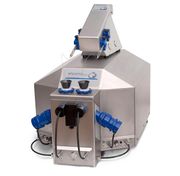Difference between revisions of "High-resolution respirometry"
| Line 2: | Line 2: | ||
|abbr=HRR | |abbr=HRR | ||
|description=[[Image:O2k-Fluorometer.JPG|180px|left|link=O2k-FluoRespirometer]] | |description=[[Image:O2k-Fluorometer.JPG|180px|left|link=O2k-FluoRespirometer]] | ||
Mitochondrial function and dysfunction have gained an increasing interest over the past years, reflecting growing awareness of the fact that mitochondria play a pivotal role in human health and disease. The most advanced way to analyze mitochondrial function is by means of high-resolution respirometry using the [[ | Mitochondrial function and dysfunction have gained an increasing interest over the past years, reflecting growing awareness of the fact that mitochondria play a pivotal role in human health and disease. The most advanced way to analyze mitochondrial function is by means of '''high-resolution respirometry''' and [[High-Resolution FluoRespirometry]] using the [[Oroboros O2k]]. Substrate-uncoupler-inhibitor titration (SUIT) protocols allow the diagnosis of numerous mitochondrial pathway and coupling defects in a single respirometric assay. Technologically, HRR is based on the Oroboros O2k, combining optimized chamber design, application of oxygen-tight materials, electrochemical sensors, Peltier-temperature control and specially developed software features (DatLab) to obtain the unique sensitive and quantitative resolution of oxygen concentration and oxygen flux, with both, a closed-chamber or open-chamber mode of operation ([[TIP2k-Module|TIP2k]]). Standardized calibration of the polarographic oxygen sensor (static sensor calibration), calibration of the sensor response time (dynamic sensor calibration), and evaluation of instrumental background oxygen flux (systemic flux compensation) provide the experimental basis for high accuracy of quantitative results and quality control in HRR. The most important extension of the [[O2k-Respirometer]] is the [[O2k-FluoRespirometer]]. | ||
'''High-resolution respirometry''' (HRR) is defined on the basis of instrumental features of the O2k. The limit of detection of oxygen flux is as low as 1 pmol O<sub>2</sub>.s<sup>-1</sup>.ml<sup>-1</sup>. Oxygen backdiffusion at zero oxygen is <4 pmol.s<sup>-1</sup>.ml<sup>-1</sup>. Oxygen consumption by the polarographic oxygen sensor at air saturation and standard barometric pressure (100 kPa) is 2.7 pmol.s<sup>-1</sup>.ml<sup>-1</sup> (± 0.9 SD; 114 test runs at 37 °C). These highly standardized instrumental background fluxes are a linear function of oxygen concentration, which is used for automatic background correction of oxygen flux (DatLab). Typical exponential time constants of the oxygen sensors are <4 s, used for dynamic corrections in kinetic studies. Signal noise at zero oxygen concentration is <0.05 µM O<sub>2</sub>. | '''High-resolution respirometry''' (HRR) is defined on the basis of instrumental features of the O2k. The limit of detection of oxygen flux is as low as 1 pmol O<sub>2</sub>.s<sup>-1</sup>.ml<sup>-1</sup>. Oxygen backdiffusion at zero oxygen is <4 pmol.s<sup>-1</sup>.ml<sup>-1</sup>. Oxygen consumption by the polarographic oxygen sensor at air saturation and standard barometric pressure (100 kPa) is 2.7 pmol.s<sup>-1</sup>.ml<sup>-1</sup> (± 0.9 SD; 114 test runs at 37 °C). These highly standardized instrumental background fluxes are a linear function of oxygen concentration, which is used for automatic background correction of oxygen flux (DatLab). Typical exponential time constants of the oxygen sensors are <4 s, used for dynamic corrections in kinetic studies. Signal noise at zero oxygen concentration is <0.05 µM O<sub>2</sub>. | ||
| Line 48: | Line 48: | ||
== MitoPedia: O2k == | |||
== MitoPedia: O2k | |||
::::» [[MitoPedia: O2k hardware]] | ::::» [[MitoPedia: O2k hardware]] | ||
::::» [[MitoPedia: DatLab]] | ::::» [[MitoPedia: DatLab]] | ||
Revision as of 14:27, 18 July 2017
Description
Mitochondrial function and dysfunction have gained an increasing interest over the past years, reflecting growing awareness of the fact that mitochondria play a pivotal role in human health and disease. The most advanced way to analyze mitochondrial function is by means of high-resolution respirometry and High-Resolution FluoRespirometry using the Oroboros O2k. Substrate-uncoupler-inhibitor titration (SUIT) protocols allow the diagnosis of numerous mitochondrial pathway and coupling defects in a single respirometric assay. Technologically, HRR is based on the Oroboros O2k, combining optimized chamber design, application of oxygen-tight materials, electrochemical sensors, Peltier-temperature control and specially developed software features (DatLab) to obtain the unique sensitive and quantitative resolution of oxygen concentration and oxygen flux, with both, a closed-chamber or open-chamber mode of operation (TIP2k). Standardized calibration of the polarographic oxygen sensor (static sensor calibration), calibration of the sensor response time (dynamic sensor calibration), and evaluation of instrumental background oxygen flux (systemic flux compensation) provide the experimental basis for high accuracy of quantitative results and quality control in HRR. The most important extension of the O2k-Respirometer is the O2k-FluoRespirometer.
High-resolution respirometry (HRR) is defined on the basis of instrumental features of the O2k. The limit of detection of oxygen flux is as low as 1 pmol O2.s-1.ml-1. Oxygen backdiffusion at zero oxygen is <4 pmol.s-1.ml-1. Oxygen consumption by the polarographic oxygen sensor at air saturation and standard barometric pressure (100 kPa) is 2.7 pmol.s-1.ml-1 (± 0.9 SD; 114 test runs at 37 °C). These highly standardized instrumental background fluxes are a linear function of oxygen concentration, which is used for automatic background correction of oxygen flux (DatLab). Typical exponential time constants of the oxygen sensors are <4 s, used for dynamic corrections in kinetic studies. Signal noise at zero oxygen concentration is <0.05 µM O2.
Abbreviation: HRR
Reference: Gnaiger 1995 J Bioenerg Biomembr
MitoPedia methods:
Respirometry,
Fluorometry,
Spectrophotometry
MitoPedia O2k and high-resolution respirometry:
DatLab
- » Keywords
- Instrument
- » DatLab; » MitoPedia: DatLab
- » Instrumental background oxygen flux »» MiPNet14.06 Instrumental O2 background
- » O2k-Core
- » O2k-FluoRespirometer
- » O2k-MultiSensor
- » Oroboros O2k; » MitoPedia: O2k hardware
- » Power-O2k
- » Static sensor calibration
- » TIP2k
- Instrument
- Concept
MitoPedia: O2k
Links
- » References
- O2k-Publications




